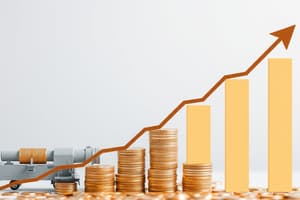Podcast
Questions and Answers
Which term refers specifically to the rate of growth of real GDP during a specific period?
Which term refers specifically to the rate of growth of real GDP during a specific period?
- Potential Economic Growth
- Output Gap
- Actual Economic Growth (correct)
- Export-Led Growth
How can an economy achieve an increase in capacity output?
How can an economy achieve an increase in capacity output?
- By reducing investment in capital goods
- By decreasing the quantity of factors of production
- By improving the efficiency of existing production factors (correct)
- By focusing solely on labor productivity
What best describes human capital in the context of economic growth?
What best describes human capital in the context of economic growth?
- The combined productivity of labor and capital
- The monetary investment in physical assets
- The stock of skills and expertise of workers (correct)
- The total output produced by all economic factors
What is the primary implication of an output gap occurring in an economy?
What is the primary implication of an output gap occurring in an economy?
Which factor is NOT typically considered a source of economic growth?
Which factor is NOT typically considered a source of economic growth?
What is the primary factor that can prevent the installation of high-tech equipment from leading to growth?
What is the primary factor that can prevent the installation of high-tech equipment from leading to growth?
Which scenario describes a situation which will not affect the overall productive capacity of an economy?
Which scenario describes a situation which will not affect the overall productive capacity of an economy?
What characterizes potential economic growth that makes it difficult to identify?
What characterizes potential economic growth that makes it difficult to identify?
In the context of the AD/AS diagram, what indicates a fall in potential capacity output?
In the context of the AD/AS diagram, what indicates a fall in potential capacity output?
Flashcards
Actual Economic Growth
Actual Economic Growth
The change in the level of real GDP over a period of time.
Potential Economic Growth
Potential Economic Growth
The potential output of an economy when all factors of production are fully and efficiently utilized.
Output Gap
Output Gap
The difference between actual real GDP and potential real GDP.
Investment
Investment
Signup and view all the flashcards
Productivity
Productivity
Signup and view all the flashcards
Economic Growth
Economic Growth
Signup and view all the flashcards
How to visualize Economic Growth?
How to visualize Economic Growth?
Signup and view all the flashcards
Actual Growth
Actual Growth
Signup and view all the flashcards
Potential Growth
Potential Growth
Signup and view all the flashcards
Study Notes
Economic Growth
- One of society's main goals is to improve living standards and well-being, which requires increasing available resources. Economic growth, expanding resources, is a key element in this process.
Defining Economic Growth
- Potential growth is an increase in an economy's productive capacity. This is visually represented by a shift in the Production Possibility Frontier (PPF), enabling the production of more goods/services.
- Actual growth, measured by the rate of change in real GDP, may reflect a move towards this potential.
- The AD/AS model can illustrate growth as a shift in the LRAS (long-run aggregate supply) curve outwards. This shift increases full employment output.
- Actual GDP is observable, while potential GDP is the level of output if all resources are used efficiently.
The Output Gap
- The output gap is the difference between actual real GDP and its maximum possible level (potential GDP).
- A negative output gap below full employment means unused resources (unemployment, idle capital).
- A positive output gap shows actual GDP exceeding capacity, often a short-term response to increased demand. Measuring the output gap is challenging as identifying the exact point of full capacity is difficult.
Sources of Economic Growth
- Factors of production (capital, labor, enterprise, land) are crucial.
- An increase in production factors or their productivity elevates capacity output.
- Productivity is a measure of a factor's efficiency (labor productivity = output/worker, etc.).
- Total Factor Productivity (TFP) is the average productivity of all factors.
- Increased productivity boosts aggregate supply and potential output.
Capital
- Capital is essential for production increases.
- Investment (in capital goods) is crucial for accumulating and expanding capital.
- Gross fixed capital formation (net additions to capital, and depreciation) is a key measure of investment.
- Technological advancements (and new forms of capital) increase capital's contribution to potential output.
Labour
- Skilled labor is needed to operate new technologies and capital.
- Labor force size is limited by factors like international migration.
- Labor productivity gains through training and education are key.
Growth and International Trade
- International trade can boost economic growth in smaller countries by enabling specialization and economies of scale (producing more efficiently).
- Expanding export markets can lead to export-led growth, as shown in several East Asian economies.
- Access to larger markets and foreign exchange are essential for many developing countries.
Growth and Aggregate Demand
- An increase in aggregate demand leads to higher real output, especially when initial output is below full potential.
- This is considered actual growth, not a change in capacity.
- Investment-driven increases in AD can lead to increases in productive capacity.
Studying That Suits You
Use AI to generate personalized quizzes and flashcards to suit your learning preferences.




